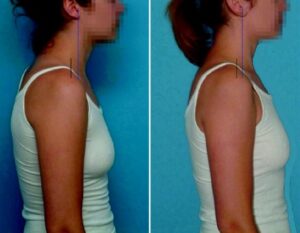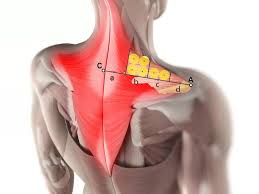

Botox injections have long been a go-to solution for cosmetic enhancements and treating conditions like migraines and muscle spasms.
Recently, they’ve been explored as a potential remedy for forward head posture (FHP). But is this a revolutionary treatment or just another short-lived trend?
This article by bestforwardheadposturefix.com delves into the science behind using Botox for FHP and weighs its benefits against its risks.
Article Index:
- What is Forward Head Posture?
- How Can Botox Help?
- Botox in the Trapezius: Does it Really Work?
- The Science Behind Botox for Neck Muscles
- Potential Risks and Side Effects
- Comparing Botox with Other Treatments
- FAQs on Botox for Managing Forward Head Posture
- Conclusion: Miracle or Misguided Trend?
What is Forward Head Posture?
Forward head posture (FHP) is a condition where the head juts forward relative to the spine, causing strain on the neck and upper back muscles.
This misalignment often results from poor posture, extended use of electronic devices, or weak neck muscles.
Over time, FHP can lead to chronic pain, headaches, and even respiratory issues due to the altered alignment of the cervical spine.
How Can Botox Help?
Botox, or Botulinum toxin, is a neurotoxin that temporarily paralyzes muscles.
In the case of FHP, Botox injections are used to relax overactive muscles, such as the trapezius and sternocleidomastoid, which can contribute to the forward pull of the head.
This relaxation allows for better alignment of the neck and can help alleviate pain associated with muscle tension.
Botox in the Trapezius: Does it Really Work?
One of the most common applications is “trapezius botox,” where Botox is injected into the trapezius muscle.
This muscle often becomes hypertrophied and tense in individuals with FHP.
A study published in The Journal of Pain Research showed that patients receiving Botox in the trapezius experienced significant relief from neck pain and improved posture.
However, the results were temporary, requiring repeated treatments to maintain the benefits.
The Science Behind Botox for Neck Muscles
Botox injections for neck muscles, such as the trapezius and sternocleidomastoid, can temporarily reduce muscle activity.
This helps in relieving muscle tension and allows for better postural correction. Research indicates that “botox for trapezius muscle” injections can improve the alignment of the cervical spine and reduce associated pain symptoms.
A study conducted by the American Academy of Neurology found that patients who received “botox in neck before and after” showed marked improvement in pain levels and achieve best forward head posture fix within weeks of the treatment.
Potential Risks and Side Effects
Muscle Weakness and Limited Range of Motion
- Botox works by temporarily paralyzing targeted muscles, which can lead to unintended muscle weakness.
- This weakening may reduce the range of motion, affecting daily activities and overall neck function.
Difficulty Swallowing (Dysphagia)
- Injections in the cervical region can impact muscles involved in swallowing, leading to dysphagia.
- According to research from BotoxOne, approximately 19% of patients receiving Botox for cervical dystonia experience difficulty swallowing (BotoxOne, 2024).
Respiratory Complications
- If Botox diffuses near the phrenic nerve, which controls the diaphragm, it can lead to breathing difficulties.
- A study published in the National Center for Biotechnology Information (NCBI) reported cases of diaphragmatic paralysis following Botox injections, highlighting the importance of precise administration (NCBI, 2024).
Spread of Toxin Effects
- Botox may migrate from the injection site, potentially causing generalized muscle weakness, vision problems, and breathing difficulties.
- These side effects can appear within hours to weeks after the injection, according to BotoxCervicalDystonia.com (2024).
Injection Site Reactions
- Common localized side effects include pain, swelling, and bruising at the injection site.
- These reactions are typically mild and resolve within a few days.
Potential for Botulinum Toxin Resistance
- Repeated Botox injections may lead to the development of neutralizing antibodies, reducing treatment efficacy over time.
- Research from NCBI indicates that long-term Botox use may contribute to resistance, complicating future treatments (NCBI, 2024).
Systemic Adverse Reactions
- Although rare, systemic effects such as flu-like symptoms and fatigue have been reported.
- Patients are advised to monitor for any unusual symptoms post-treatment and seek medical attention if necessary.
While Botox can be an effective treatment for certain conditions, its use for FHP carries potential risks.
Studies emphasize the importance of thorough patient evaluation and precise injection techniques to avoid complications. Consulting with a qualified healthcare provider is essential before considering Botox therapy for forward head posture.
Comparing Botox with Other Treatments
While Botox offers temporary relief, it’s important to compare it with other treatment options.
Physical therapy, chiropractic adjustments, and exercises aimed at strengthening the deep neck flexors can provide long-term benefits without the need for repeated injections.
A comparative study in the Journal of Orthopedic & Sports Physical Therapy found that while Botox can provide immediate relief, exercises like neck tilts and scapular retraction showed more sustainable improvements in posture and pain management.
For instance, “botox for muscle spasms in neck” might provide quick relief from severe spasms, but regular stretching and strengthening exercises are essential for maintaining long-term neck health.
Similarly, “botox injections for neck pain” can help when conventional methods fail, but they should not be seen as a first-line treatment.
FAQs on Botox for Managing Forward Head Posture
Q1: How does Botox work in treating forward head posture (FHP)?
A1: Botox is a neurotoxin that temporarily paralyzes muscles by blocking nerve signals. For forward head posture, it targets overactive neck muscles to reduce tension and alleviate discomfort caused by poor alignment.
Q2: What are the potential benefits of using Botox for FHP correction?
A2: Botox can provide temporary relief from muscle tension and pain associated with forward head posture. By relaxing tight muscles, it may improve neck mobility and reduce discomfort in a non-invasive manner.
Q3: Are there risks or side effects associated with Botox treatment for FHP?
A3: Yes, Botox treatment carries risks such as temporary muscle weakness, which can affect daily activities and posture. Some people might experience difficulty swallowing or flu-like symptoms including fatigue and mild fever. Consulting a healthcare professional is essential before treatment.
Q4: Does Botox address the underlying causes of forward head posture?
A4: No, Botox mainly offers temporary symptom relief and does not correct the structural or postural causes of forward head posture. Long-term improvement generally requires a combination of physical therapy, ergonomic changes, and postural training.
Q5: Are there alternative treatments to Botox for managing forward head posture?
A5: Yes, alternatives include physical therapy to strengthen and stretch muscles, ergonomic adjustments to improve daily posture habits, chiropractic care to realign the spine, and education on maintaining proper posture. These address the root causes of FHP and offer sustained benefits.
Q6: Is Botox a suitable treatment for everyone with forward head posture?
A6: Botox may not be appropriate for all individuals. The suitability depends on factors like condition severity, overall health, and other medical considerations. A comprehensive evaluation by a healthcare professional is necessary to determine if Botox is an appropriate option.
Conclusion: Miracle or Misguided Trend?
So, is Botox for forward head posture a miracle fix or a misguided trend?
The answer lies in its application.
Botox can be a powerful tool for short-term relief, especially for those suffering from severe muscle spasms or pain that does not respond to other treatments. However, it should not be viewed as a standalone solution.
The best approach combines Botox with a comprehensive physical therapy program focused on strengthening and realigning the neck muscles.
In summary, while Botox offers promising results for those struggling with FHP, it is not a permanent solution.
The key to effective treatment lies in addressing the root causes of the posture issue, rather than relying solely on injections to mask the symptoms.
References:

